air condition MERCEDES-BENZ E43AMG 2017 W213 Owner's Manual
[x] Cancel search | Manufacturer: MERCEDES-BENZ, Model Year: 2017, Model line: E43AMG, Model: MERCEDES-BENZ E43AMG 2017 W213Pages: 482, PDF Size: 6.31 MB
Page 25 of 482
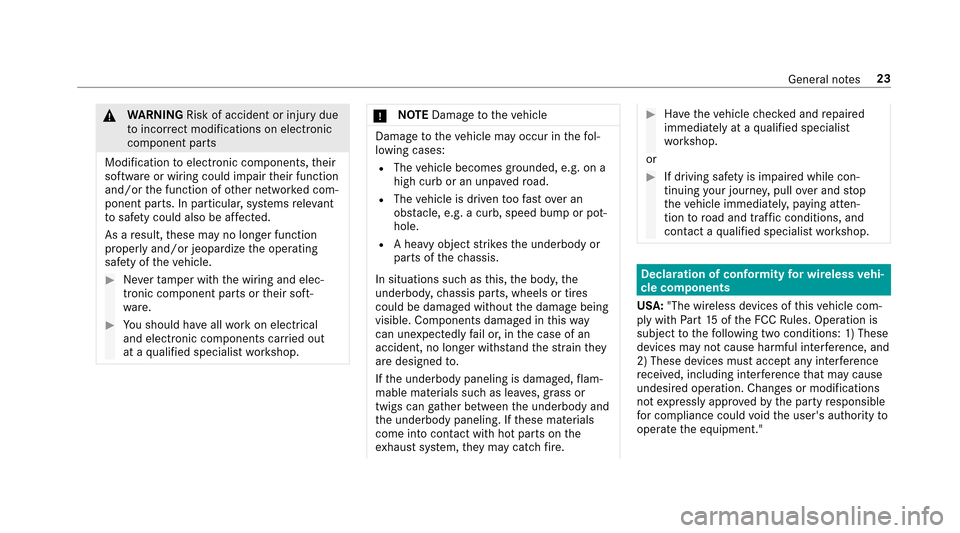
&WARNING Risk of accident or injury due
to incor rect modifications on electronic
component part s
Modification toelectronic components, their
software or wiring could impair their function
and/or the function of other networ ked com‐
ponent parts. In particular, sy stems releva nt
to saf etycould also be af fected.
As a result, these may no longer function
proper lyand/or jeopardize the operating
saf etyof theve hicle.
#Ne verta mp er with the wiring and elec‐
tronic component parts or their soft‐
wa re.
#Yo u should ha veall workon electrical
and electronic components car ried out
at a qualified specialist workshop.
* NO
TEDama getotheve hicle
Damage totheve hicle may occur in thefo l‐
lowing cases:
RThe vehicle becomes grounded, e.g. on a
high curb or an unpa vedro ad.
RThe vehicle is driven toofast over an
obs tacle, e.g. a curb, speed bump or pot‐
hole.
RA heavy object strike sth e underbody or
parts of thech assis.
In situations such as this, the body, the
underbody, chassis parts, wheels or tires
could be damaged without the damage being
visible. Components damaged in this wa y
can unexpectedly fail or, in the case of an
accident, no longer withs tand thest ra in they
are designed to.
If th e underbody paneling is damaged, flam‐
mable materials such as lea ves, grass or
twigs can gather between the underbody and
th e underbody paneling. If these materials
come into conta ct withhot parts on the
ex haust sy stem, they may catch fire .
#Ha ve theve hicle checked and repaired
immediately at a qualified specialist
wo rkshop.
or
#If driving saf etyis impaired while con‐
tinuing your journe y,pull over and stop
th eve hicle immediatel y,paying atten‐
tion toroad and traf fic conditions, and
contact a qualified specialist workshop.
Declaration of conformity for wi reless vehi‐
cle co mponents
USA: "The wireless devices of this vehicle com‐
ply with Part15 ofthe FCC Rules. Operation is
subject tothefo llowing two conditions: 1) These
devices may not cause harmful inter fere nce, and
2) These devices must accept any interfere nce
re ceive d, including inter fere nce that may cause
undesired operation. Change s or modifications
not expressly appr ovedby the party responsible
fo r compliance could void the user's authority to
operate the equipment."
General no tes 23
Page 29 of 482
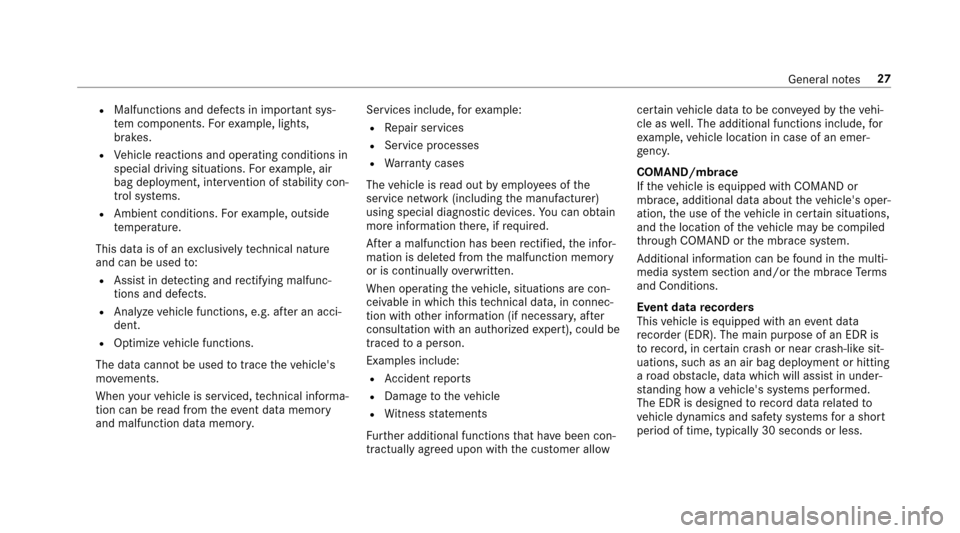
RMalfunctions and defects in important sys‐
te m components. Forex ample, lights,
brakes.
RVe hicle reactions and operating conditions in
special driving situations. Forex ample, air
bag deployment, inter vention of stability con‐
trol sy stems.
RAmbient conditions. Forex ample, outside
te mp erature.
This data is of an exclusively tech nical natu re
and can be used to:
RAssist in detecting and rectifying malfunc‐
tions and defects.
RAnalyze vehicle functions, e.g. af ter an acci‐
dent.
ROptimize vehicle functions.
The data cannot be used totrace theve hicle's
mo vements.
When your vehicle is serviced, tech nical informa‐
tion can be read from theeve nt da tamemory
and malfunction data memor y.Services include,
forex ample:
RRe pair services
RService processes
RWa rranty cases
The vehicle is read out byemplo yees of the
service network (including the manufacturer)
using special diagnostic devices. You can obtain
more information there, if requ ired.
Af ter a malfunction has been rectified, the infor‐
mation is dele ted from the malfunction memory
or is continually overwritten.
When operating theve hicle, situations are con‐
ceivable in which this tech nical da ta, in connec‐
tion with other information (if necessar y,afte r
consultation wi than authorized expert), could be
traced toa person.
Examples include:
RAc
cident reports
RDamage totheve hicle
RWi tness statements
Fu rther additional functions that ha vebeen con‐
tractually agreed upon with the cus tomer all ow cer
tain vehicle data tobe con veye dby theve hi‐
cle as well. The additional functions include, for
ex ample, vehicle location in case of an emer‐
ge ncy.
COMAND/mbrace
If th eve hicle is equipped with COMAND or
mbrace, additional data about theve hicle's oper‐
ation, the use of theve hicle in cer tain situations,
and the location of theve hicle may be compiled
th ro ugh COMAND or the mbrace sy stem.
Ad ditional information can be found in the multi‐
media sy stem section and/or the mbrace Term s
and Conditions.
Event data recorders
This vehicle is equipped with an event da ta
re corder (EDR). The main purp ose of an EDR is
to record, in cer tain crash or near crash-like sit‐
uations, such as an air bag deployment or hitting
a ro ad obs tacle, data which will assist in under‐
st anding how a vehicle's sy stems per form ed.
The EDR is designed torecord data related to
ve hicle dynamics and saf etysy stems for a short
period of time, typically 30 seconds or less.
General no tes 27
Page 34 of 482
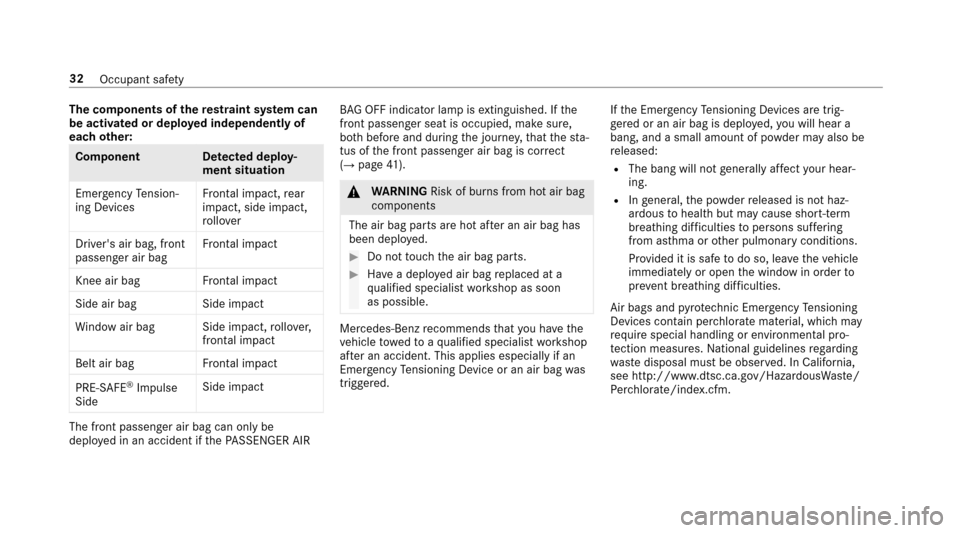
The components of there stra int sy stem can
be activated or deplo yed independently of
each other:
Component De tected deploy‐
ment situation
Emer gency Tension‐
ing Devices Fr
ontal impact, rear
impact, side impact,
ro llo ver
Driver's air bag, front
passenger air bag Fr
ontal impact
Knee air bag Frontal impact
Side air bag Side impact
Wi ndow air ba gS ide impact,rollo ver,
frontal impact
Belt air bag Frontal impact
PRE-SAFE®Impulse
Side Side impact
The front passenger air bag can only be
deplo
yed in an accident if thePA SSENGER AIR BA
G OFF indicator lamp is extinguished. If the
front passenger seat is occupied, make sure,
bo th before and during the journe y,that thest a‐
tus of the front passenger air bag is cor rect
(
→page 41).
&
WARNING Risk of burn s from hot air bag
components
The air bag parts are hot af ter an air bag has
been deploy ed.
#Do nottouch the air bag parts.
#Ha ve a deplo yed air bag replaced at a
qu alified specialist workshop as soon
as possible.
Mercedes-Benz recommends that you ha vethe
ve hicle towe dto aqu alified specialist workshop
af te r an accident. This applies especial lyif an
Emer gency Tensioning Device or an air bag was
trig gered. If
th e Emer gency Tensioning Devices are trig‐
ge red or an air bag is deplo yed, youwill hear a
bang, and a small amount of po wdermay also be
re leased:
RThe bang will not generally af fect your hear‐
ing.
RIn general, the powder released is not haz‐
ardous tohealth but may cause short-term
breathing dif ficulties topersons suf fering
from as thma or other pulmonary conditions.
Pr ov ided it is safe todo so, lea vetheve hicle
immediately or open the window in order to
pr eve nt brea thing dif ficulties.
Air bags and pyrotech nic Emergency Tensioning
Devices contain pe rchlorate material, which may
re qu ire special handling or environmental pro‐
te ction measure s.Na tional guidelines rega rding
wa ste disposal must be obser ved. In California,
see http://www.dtsc.ca.gov/HazardousWas te/
Pe rchlorate/index.cfm.
32
Occupant saf ety
Page 49 of 482
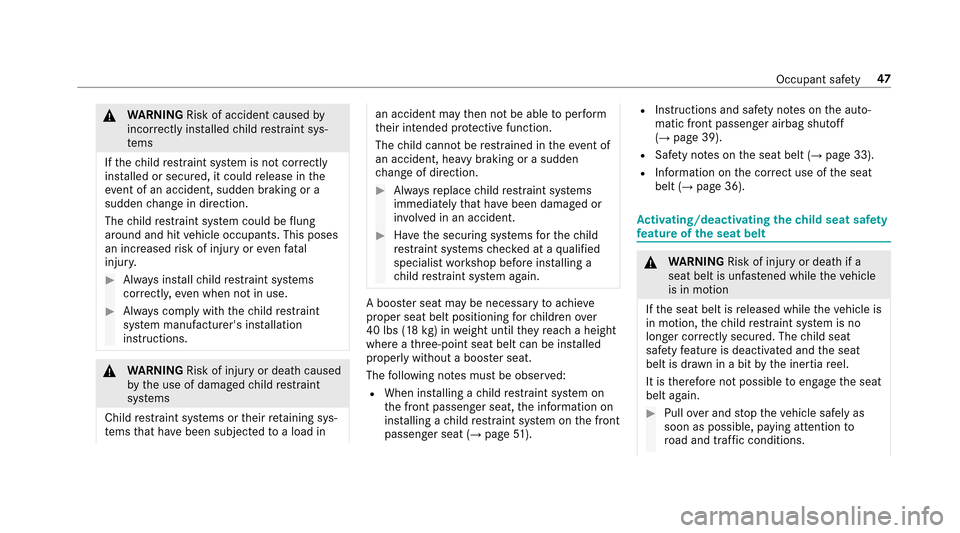
&WARNING Risk of accident caused by
incor rectly ins talled child restra int sys‐
te ms
If th ech ild restra int sy stem is not cor rectly
ins talled or secured, it could release in the
ev ent of an accident, sudden braking or a
sudden change in direction.
The child restra int sy stem could be flung
around and hit vehicle occupants. This poses
an increased risk of injury or even fata l
injur y.
#Always ins tallch ild restra int sy stems
cor rectl y,eve n when not in use.
#Alw ays comply with thech ild restra int
sy stem manufacturer's ins tallation
instructions.
& WARNING Risk of injury or death caused
by the use of damaged child restra int
sy stems
Child restra int sy stems or their retaining sys‐
te ms that ha vebeen subjec tedto a load in
an accident may then not be able toper form
th eir intended pr otective function.
The child cannot be restra ined in theeve nt of
an accident, heavy braking or a sudden
ch ange of direction.
#Alw aysre place child restra int sy stems
immediately that ha vebeen damaged or
in vo lved in an accident.
#Ha ve the securing sy stems forth ech ild
re stra int sy stems checked at a qualified
specialist workshop before ins talling a
ch ild restra int sy stem again.
A boos ter seat may be necessary toachie ve
proper seat belt positioning forch ildren over
40 lbs (18 kg) in weight until they reach a height
where a thre e-point seat belt can be ins talled
proper lywithout a boos ter seat.
The following no tes must be obser ved:
RWhen ins talling a child restra int sy stem on
th e front passenger seat, the information on
ins talling a child restra int sy stem on the front
passenger seat (
→page 51).
RInstructions and saf etyno tes on the auto‐
matic front passenger airbag shutoff
(
→page 39).
RSaf etyno tes on the seat belt (→page 33).
RInformation on the cor rect use of the seat
belt (→page 36).
Ac tivating/deactivating the child seat saf ety
fe ature of the seat belt
&
WARNING Risk of injury or death if a
seat belt is unfas tened while theve hicle
is in motion
If th e seat belt is released while theve hicle is
in motion, thech ild restra int sy stem is no
longer cor rectly secure d. Thechild seat
saf etyfe ature is deactivated and the seat
belt is dr awn in a bit bythe inertia reel.
It is therefore not possible toengage the seat
belt again.
#Pull over and stop theve hicle safely as
soon as possible, paying attention to
ro ad and traf fic conditions.
Occupant saf ety 47
Page 83 of 482
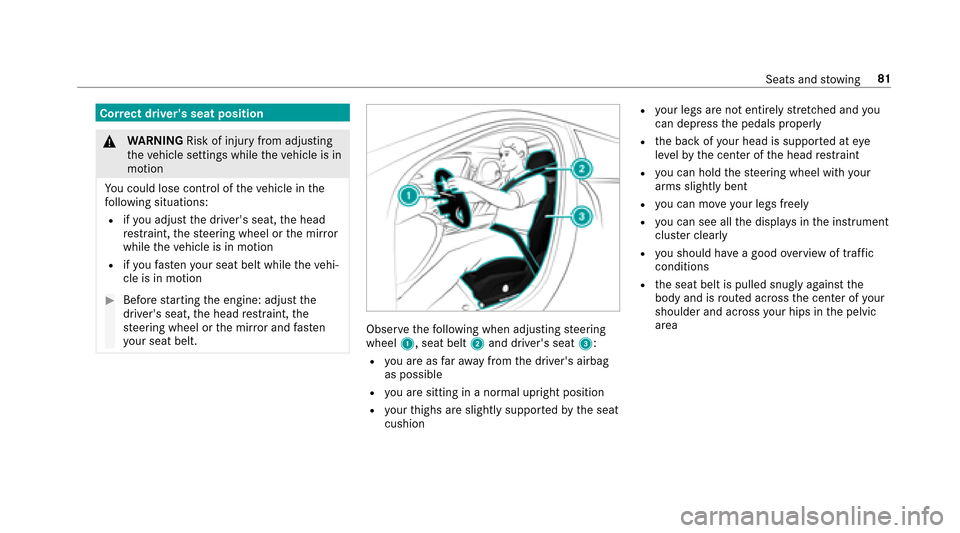
Correct driver's seat position
&
WARNING Risk of injury from adjusting
th eve hicle settings while theve hicle is in
motion
Yo u could lose cont rol of theve hicle in the
fo llowing situations:
Rifyo u adjust the driver's seat, the head
re stra int, thesteering wheel or the mir ror
while theve hicle is in motion
Rifyo ufa sten your seat belt while theve hi‐
cle is in motion
#Before starting the engine: adjust the
driver's seat, the head restra int, the
st eering wheel or the mir ror and fasten
yo ur seat belt.
Obser vethefo llowing when adjusting steering
wheel 1, seat belt 2and driver's seat 3:
Ryou are as faraw ay from the driver's airbag
as possible
Ryo u are sitting in a no rmal upright position
Ryour thighs are slightly supportedby the seat
cushion
Ryo ur legs are not entirely stre tched and you
can dep ress the pedals properly
Rthe back of your head is support ed ateye
le ve lby the center of the head restra int
Ryo u can hold thesteering wheel with your
arms slightly bent
Ryo u can mo veyour legs freely
Ryou can see all the displa ysinthe instrument
clus ter clearl y
Ryou should ha vea good overview of traf fic
conditions
Rth e seat belt is pulled snugly against the
body and is routed across the center of your
shoulder and across your hips in the pelvic
area
Seats and stowing 81
Page 112 of 482
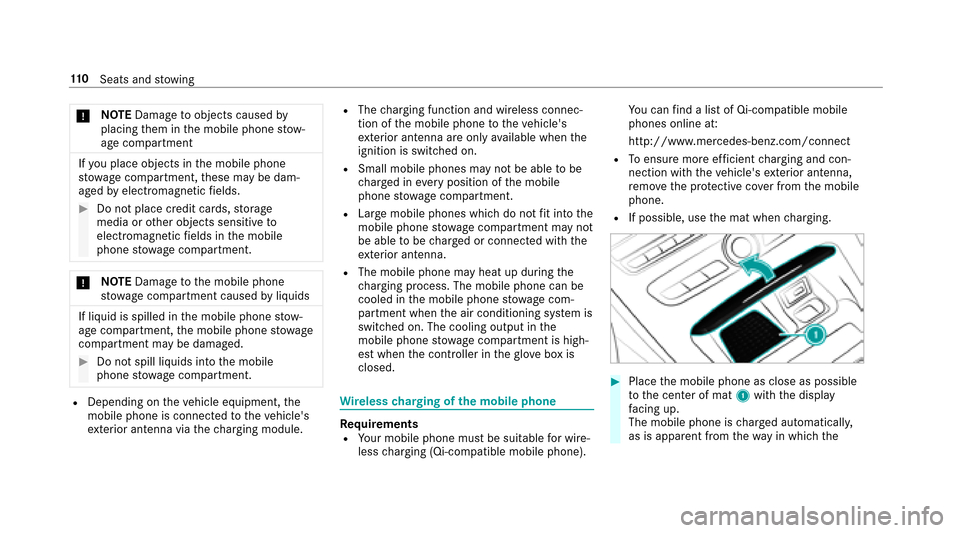
*NO
TEDama getoobjects caused by
placing them in the mobile phone stow‐
age compartment
If yo uplac e objects inthe mobile phone
stow age compartment, these may be dam‐
aged byelectromagnetic fields.
#Do not place credit cards, storage
media or other objects sensitive to
electromagnetic fields in the mobile
phone stowage compartment.
* NO
TEDama getothe mobile phone
stow age compartment caused byliquids
If liquid is spilled in the mobile phone stow‐
age compartment, the mobile phone stowage
compartment may be damaged.
#Do not spill liquids into the mobile
phone stowage compartment.
RDepending on theve hicle equipment, the
mobile phone is connected totheve hicle's
ex terior antenna via thech arging module.
RThe charging function and wireless connec‐
tion of the mobile phone totheve hicle's
ex terior antenna are only available when the
ignition is switched on.
RSmall mobile phones may not be able tobe
ch arge d in every position of the mobile
phone stowage compartment.
RLargemobile phones which do not fit into the
mobile phone stowage compartment may not
be able tobe charge d or connec ted with the
ex terior antenna.
RThe mobile phone may heat up during the
ch arging process. The mobile phone can be
cooled in the mobile phone stowage com‐
partment when the air conditioning sy stem is
switched on. The cooling output in the
mobile phone stowage compartment is high‐
est when the controller in theglove box is
closed.
Wire lesscharging of the mobile phone
Requ irementsRYour mobile phone must be suit ablefor wire‐
less charging (Qi-compatible mobile phone). Yo
u can find a li stof Qi-compatible mobile
phones online at:
http://www.mercedes-benz.com/connect
RTo ensure more ef ficient charging and con‐
nection with theve hicle's exterior antenna,
re mo vethe pr otective co ver from the mobile
phone.
RIf possible, use the mat when charging.
#Place the mobile phone as close as possible
to the center of mat 1with the display
fa cing up.
The mobile phone is charge d automatically,
as is apparent from thewa yin whic hth e
11 0
Seats and stowing
Page 117 of 482
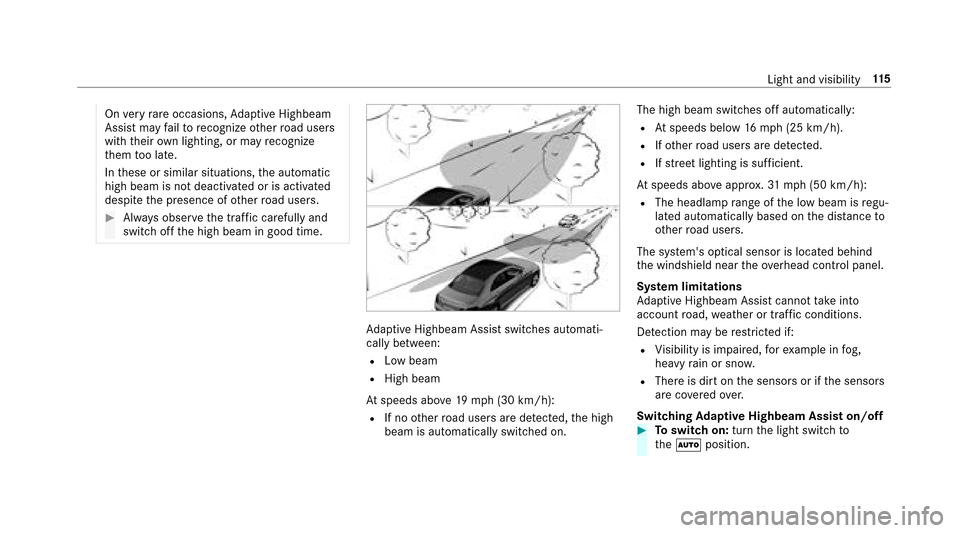
Onvery rare occasions, Adaptive Highbeam
Assist may failto recognize other road users
with their own lighting, or may recognize
th em too late.
In these or similar situations, the automatic
high beam is not deactivated or is activated
despite the presence of other road users.
#Alw ays obser vethe tra ffic carefully and
switch off the high beam in good time.
Ad aptive Highbeam Assist switch es automati‐
cally between:
RLow beam
RHigh beam
At speeds abo ve19 mp h (30 km/h):
RIf no other road users are de tected, the high
beam is automatically switched on. The high beam switches off automatically:
RAt
speeds below 16mp h (25 km/h).
RIfot her road users are de tected.
RIfstre et lighting is suf ficient.
At speeds abo veappr ox.31 mp h(5 0 km/h):
RThe headlamp range of the low beam is regu‐
lated automatically based on the dis tance to
ot her road users.
The sy stem's optical sensor is located behind
th e windshield near theov erhead control panel.
Sy stem limitations
Ad aptive Highbeam Assist cannot take into
account road, weather or traf fic conditions.
De tection may be restricted if:
RVi sibility is impaired, forex ample in fog,
heavy rain or sno w.
RThere is dirt on the sensors or if the sensors
are co veredove r.
Switching Adaptive Highbeam Assist on/off
#To switch on: turnthe light switch to
th eà position.
Light and visibility 11
5
Page 153 of 482
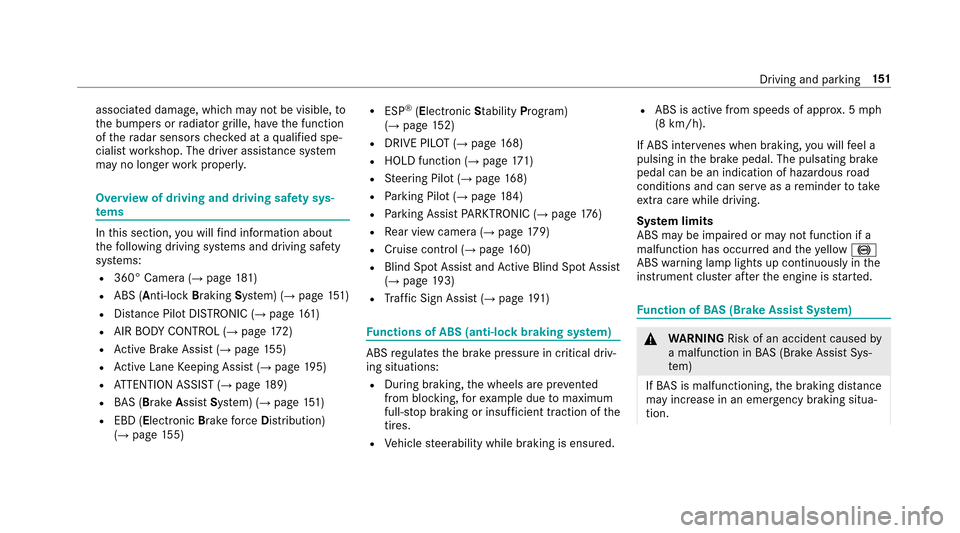
associated damage, which may not be visible,to
th e bumpers or radiator grille, ha vethe function
of thera dar sensors checked at a qualified spe‐
cialist workshop. The driver assis tance sy stem
may no longer workproperly.
Overview of driving and driving saf ety sys‐
te ms
In this section, youwill find information about
th efo llowing driving sy stems and driving saf ety
sy stems:
R360° Camera (→page 181)
RABS ( Anti-lock Braking Sys tem) (→page 151)
RDis tance Pilot DISTRONIC (→pa ge 161)
RAIR BODY CONTROL (→page 172)
RAc tive Brake Assi st(→page 155)
RAc tive Lane Keeping Assist (→page 195)
RATTENTION ASSIST (→page 189)
RBA S (Brak eAssist System) (→page 151)
REBD ( Electronic Brakeforc eDistribution)
(→page 155)
RESP®(E lectronic Sta bility Pro gram)
(→page 152)
RDRIVE PIL OT(→page 168)
RHOLD fu nction (→page 171)
RSteering Pilot (→page 168)
RParking Pilot (→page 184)
RParking Assist PARKTRONI C (→page17 6)
RRe ar view camera (→page 179)
RCruis e control (→page 160)
RBlind Spot Assist andActive Blind Spot Assi st
(→page 193)
RTraf fic Sign Assist (→page191)
Fu nctions of ABS (anti-lock braking sy stem)
ABS regulates the brake pressure in critical driv‐
ing situations:
RDuring braking, the wheels are pr evented
from blocking, forex ample due tomaximum
full-s top braking or insuf ficient traction of the
tires.
RVe hicle steerability while braking is ensured.
RABS is active from speeds of appr ox. 5 mph
(8 km/h).
If ABS inter venes when braking, youwill feel a
pulsing in the brake pedal. The pulsating brake
pedal can be an indication of hazardous road
conditions and can ser veas a reminder totake
ex tra care while driving.
Sy stem limits
ABS may be impaired or may not function if a
malfunction has occur red and theye llow !
ABS warning lamp lights up continuously in the
instrument clus ter af terth e engine is star ted.
Fu nction of BAS (Brake Assist Sy stem)
&
WARNING Risk of an accident caused by
a malfunction in BAS (Brake Assist Sys‐
te m)
If BA S is malfunctioning, the braking dis tance
may increase in an eme rgency braking situa‐
tion.
Driving and parking 15
1
Page 165 of 482
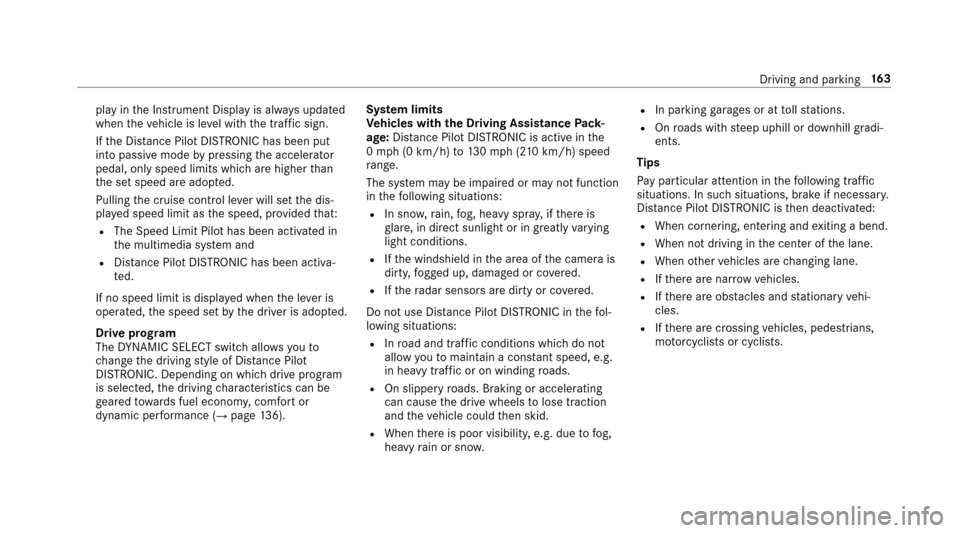
play inthe Instrument Display is alw ays update d
when theve hicle is le vel with the traf fic sign.
If th e Dis tance Pilot DISTRONIC has been put
into passive modebypressing the accelerator
pedal, only speed limits which are higher than
th e set speed are adop ted.
Pulling the cruise control le ver will set the dis‐
pla yed speed limit as the speed, pr ovided that:
RThe Speed Limit Pilot has been activated in
the multimedia sy stem and
RDis tance Pilot DISTRONIC has been acti va‐
te d.
If no speed limit is displa yed when the le ver is
operated, the speed set bythe driver is adop ted.
Drive prog ram
The DYNA MIC SELECT switch allo wsyouto
ch ange the driving style of Dis tance Pilot
DISTRONIC. Depending on which drive program
is selected, the driving characteristics can be
ge ared towa rds fuel econom y,comfort or
dynamic per form ance (
→page 136). Sy
stem limits
Ve hicles with the Driving Assistance Pack‐
age: Distance Pilot DISTRONIC is acti veinthe
0 mp h (0 km/h) to130mp h (2 10km/h) speed
ra nge.
The sy stem may be impaired or may not function
in thefo llowing situations:
RIn sno w,rain, fog, heavy spr ay, if there is
gl are, in dir ect sunlight or in greatly varying
light conditions.
RIf th e windshield in the area of the camera is
dirty, fogged up, damaged or co vered.
RIfth era dar sensors are dirty or co vered.
Do not use Dis tance Pilot DISTRONIC in thefo l‐
lowing situations:
RIn road and traf fic conditions whi chdo not
allow youto maintain a cons tant speed, e.g.
in heavy traf fic or on winding roads.
ROn slippery roads. Braking or accelerating
can cause the drive wheels tolose traction
and theve hicle could then skid.
RWhen there is poor visibility, e.g. due tofog,
heavy rain or sno w.
RIn parking garage s or at tollst ations.
ROn roads with steep uphill or downhill gradi‐
ents.
Tips
Pa yparticula rattention in thefo llowing traf fic
situations. In such situations, brake if necessar y.
Dis tance Pilot DISTRONIC is then deactivated:
RWhen cornering, entering and exiting a bend.
RWhen not driving in the center of the lane.
RWhen other vehicles are changing lane.
RIfth ere are nar rowvehicles.
RIfth ere are obs tacles and stationary vehi‐
cles.
RIf th ere are crossing vehicles, pedestrians,
mo torcyc lists or cyclists.
Driving and parking 16
3
Page 166 of 482
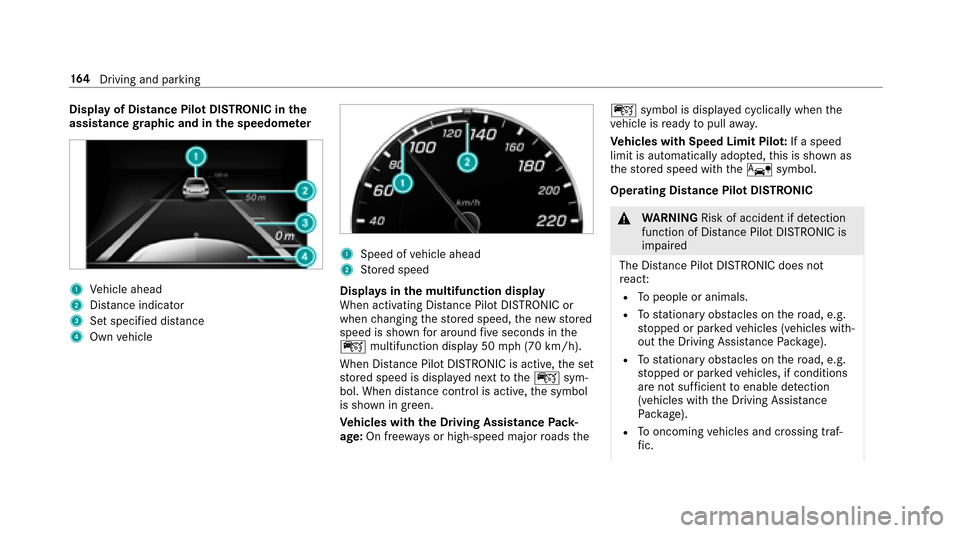
Displayof Distance Pilo tDISTRONIC in the
assist ancegraphic and in the speedome ter
1Ve hicle ahead
2Dis tance indica tor
3Set specified di stance
4Own vehicle
1Speed of vehicle ahead
2Stored speed
Displa ysinthe multifunction display
When activating Dis tance Pilot DISTRONIC or
when changing thestored speed, the new stored
speed is shown for around five seconds in the
ç multifunction display 50 mph (70 km/h).
When Dis tance Pilot DISTRONIC is acti ve,th e set
st ored speed is displa yed next totheç sym‐
bol. When dis tance control is acti ve,th e symbol
is shown in green.
Ve hicles with the Driving Assistance Pack‐
age: On free ways or high-speed major roads the ç
symbol is displa yed cyclically when the
ve hicle is ready topull away.
Ve hicles with Speed Limit Pilo t:If a speed
limit is automatical lyadop ted, this is shown as
th estored speed with theê symbol.
Operating Distance Pilot DISTRONIC
& WARNING Risk of accident if de tection
function of Dis tance Pilot DISTRONIC is
impaired
The Dis tance Pilot DISTRONIC does not
re act:
RTo people or animals.
RTostationary obstacles on thero ad, e.g.
st opped or par kedve hicles (vehicles with‐
out the Driving Assis tance Package).
RTo stationary obstacles on thero ad, e.g.
st opped or par kedve hicles, if conditions
are not suf ficient toenable de tection
(vehicles wi th the Driving Assis tance
Pa ckage).
RTo oncoming vehicles and crossing traf‐
fi c.
16 4
Driving and pa rking